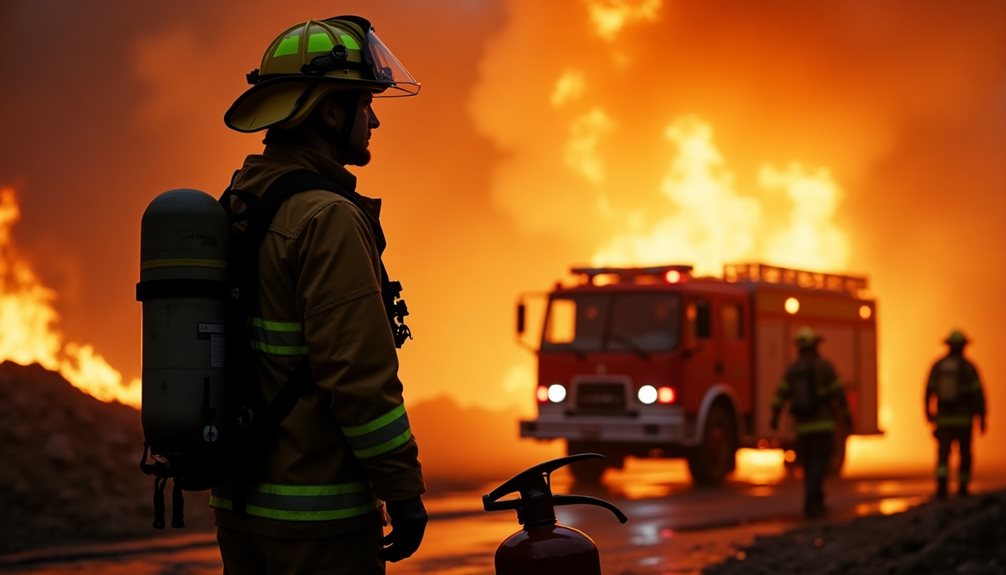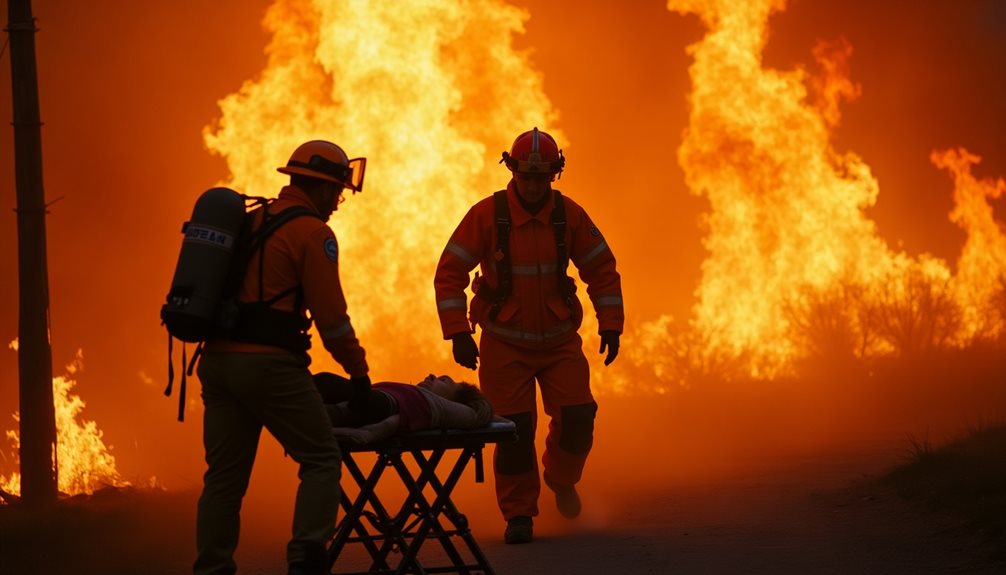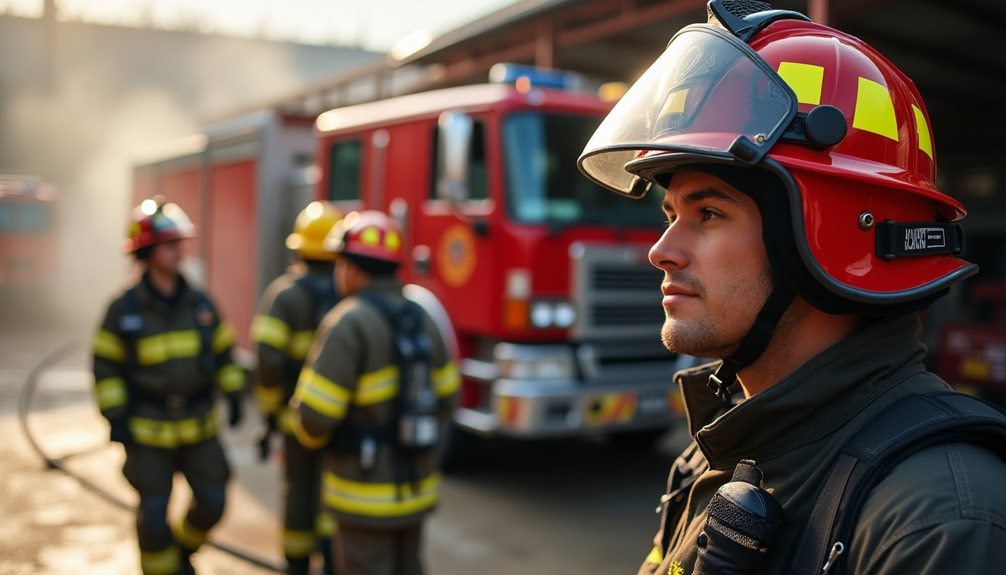Table of Contents
ToggleKey Firefighting Terms in Russian

Understanding key firefighting terms in Russian is essential for anyone involved in emergency response, whether firefighters themselves, emergency coordinators, or translators working in crisis situations. The ability to use and recognize precise terminology ensures clear communication, which can save lives and property during fire emergencies.
One of the most fundamental words is пожар (pozhár) — meaning “fire.” This term is the basis for many other related phrases. For example, пожарная безопасность (pozhárnaya bezopásnost’) means “fire safety,” a concept covering all preventive measures to avoid fires.
The act of putting out a fire is called тушение (tushéniye). Firefighters perform тушение пожара — “fire extinguishing” or “firefighting.” This involves various techniques and equipment, including огнетушитель (ognétushitel’), which means “fire extinguisher.” Fire extinguishers come in different types depending on the material they are designed to fight, such as water-based, foam, or powder extinguishers.
An important part of firefighting operations is alerting others about the danger. The phrase сигнал тревоги (signal trevógi) translates as “alarm signal.” This can refer to sirens, shouting warnings, or any alert system used to notify people about a fire.
Firefighters often carry out more complex activities under the term спасательная операция (spasátel’naya operátsiya), which means “rescue operation.” This includes saving people trapped inside burning buildings, evacuating dangerous areas, and providing first aid on site.
Additional important terms include:
- пожарный гидрант (pozhárny gidránt) — “fire hydrant,” the water source firefighters connect their hoses to.
- противопожарное оборудование (protivopozhárnoye oborúdovaniye) — “firefighting equipment,” including hoses, axes, protective clothing, and breathing apparatus.
- дымовая завеса (dymováya zavésa) — “smoke screen” or “smoke curtain,” used to control smoke spread during firefighting.
- эвакуация (evakuátsiya) — “evacuation,” the organized removal of people from a dangerous area.
- пожарная машина (pozhárnaya máshina) — “fire truck,” the vehicle equipped to transport firefighters and equipment.
Learning these terms also helps in understanding Russian firefighting protocols and manuals. For instance, the phrase порядок действий при пожаре (poryádok déystviy pri pozháre) means “procedure during a fire,” describing step-by-step actions to take during an emergency.
Effective communication during fires is critical because conditions change rapidly. Using clear terms such as угроза взрыва (ugróza vzryvá) — “explosion threat,” or опасная зона (opásnaya zóna) — “danger zone,” ensures that all team members understand risks immediately.
In summary, mastering Russian firefighting vocabulary helps emergency responders work faster and more safely. It improves coordination during high-pressure moments and supports successful fire control and rescue missions. Whether you are learning for professional reasons or personal interest, knowing these words connects you directly with the vital work firefighters do every day.
Emergency Medical Services Vocabulary
Understanding key terms used in Emergency Medical Services (EMS) is crucial for English speakers learning Russian, especially if they plan to communicate in medical settings or assist in emergencies. Below, we expand on the basic vocabulary you provided and introduce related terms that are often used by EMS professionals.
Core EMS Vocabulary
| English Term | Russian Translation | Pronunciation (Phonetic) | Definition in English |
|---|---|---|---|
| Ambulance | Скорая помощь | [SKO-rah-ya PO-moshch] | A vehicle equipped for taking sick or injured people to a hospital. |
| Patient | Пациент | [pa-TSYENT] | A person receiving or registered to receive medical treatment. |
| First Aid | Первая помощь | [PYER-va-ya PO-moshch] | Immediate assistance given to a sick or injured person before full medical treatment is available. |
| Resuscitation | Реанимация | [ree-ah-nee-MA-tsi-ya] | The act of reviving someone from unconsciousness or apparent death. |
| Essential Signs | Жизненные показатели | [ZHIZ-nen-ny-ye po-KA-za-tye-li] | Vital signs such as pulse, breathing rate, and blood pressure that indicate a patient’s health status. |
Below are additional terms that an EMS professional or learner should know. Each term includes the Russian spelling, phonetics to help with pronunciation, and an English definition.
| Russian Term | Pronunciation | English Definition |
|---|---|---|
| Врач (Doctor) | [VRAHCH] | A medical professional who diagnoses and treats patients. |
| Медсестра (Nurse) | [med-SYEST-ra] | A healthcare worker who assists doctors and cares for patients. |
| Травма (Trauma) | [TRAH-vma] | Physical injury or wound caused by external force. |
| Кровотечение (Bleeding) | [kro-va-TEE-che-nye] | Loss of blood from the circulatory system. |
| Сердцебиение (Heartbeat) | [serd-tse-BEE-ye-nye] | The pulsation of the heart as it pumps blood. |
| Дыхание (Breathing) | [DY-kha-nye] | The process of taking air into and expelling it from the lungs. |
| Транспортировка (Transport) | [trans-por-tee-ROV-ka] | The act of moving a patient from one place to another, usually to a medical facility. |
| Оказание помощи (Providing help) | [o-kaz-A-ni-ye PO-moshchi] | The act of giving assistance, especially medical aid. |
| Аптечка (First aid kit) | [ap-TYECH-ka] | A collection of supplies and equipment for use in giving first aid. |
Tips for Learning EMS Vocabulary in Russian
- Focus on pronunciation: Many Russian medical terms have roots similar to English or Latin words but are pronounced differently.
- Use flashcards with Cyrillic, phonetics, and definitions to reinforce memory.
- Practice by forming simple sentences like:
- “Скорая помощь приехала быстро.” (The ambulance arrived quickly.)
- “Пациент нуждается в реанимации.” (The patient needs resuscitation.)
- Learn verbs related to EMS such as:
- помогать (to help),
- лечить (to treat),
- спасать (to save),
- осматривать (to examine).
Understanding this vocabulary empowers responders to navigate complex scenarios confidently, ensuring peak patient outcomes. Clarity in medical terminology fosters collaboration among team members, enhancing the overall effectiveness of the EMS system.
Communication Protocols and Phrases
In emergency situations, clear and effective communication is vital. For English speakers learning Russian, understanding the right terms, phrases, and communication protocols can help ensure that information is passed quickly and accurately. This is especially important when working with Russian-speaking emergency responders or in environments where Russian is the primary language.
Why Clear Communication Is Important
- Reduces Misunderstandings: Using standardized phrases helps avoid confusion, especially when stress levels are high.
- Speeds Up Response: Clear signal codes and simple words help communicate messages quickly, even in noisy or chaotic places.
- Builds Confidence: Regular practice with these phrases makes responders more comfortable and efficient.
- Minimizes Delays: Linguistic clarity ensures that no time is wasted trying to interpret unclear instructions.
Key Russian Terms and Phrases for Emergency Communication
| Russian (Cyrillic) | English Phonetic | English Definition |
|---|---|---|
| Помощь | Pomoshch | Help / Assistance |
| Пожар | Pozhar | Fire |
| Срочно | Srochno | Urgently / Immediately |
| Опасность | Opasnost | Danger |
| Тревога | Trevoga | Alarm / Alert |
| Эвакуация | Evakuatsiya | Evacuation |
| Пострадавший | Postradavshiy | Injured person / Victim |
| Медицинская помощь | Meditsinskaya pomoshch | Medical assistance |
| Полиция | Politsiya | Police |
| Спасатели | Spasateli | Rescuers |
| Связь | Svyaz | Communication / Connection |
| Радиосвязь | Radiosvyaz | Radio communication |
| Код | Kod | Code (for signal codes) |
| Протокол | Protokol | Protocol |
| Информация | Informatsiya | Information |
| Сообщить | Soobshchit | To report / To inform |
Useful Phrases for Emergency Communication
- Нужна помощь! (Nuzhna pomoshch!) — Help is needed!
- Пожар в здании! (Pozhar v zdanii!) — Fire in the building!
- Эвакуируйтесь немедленно! (Evakuiruytes nemedlenno!) — Evacuate immediately!
- Есть пострадавшие! (Yest postradavshie!) — There are injured people!
- Связь прервана. (Svyaz prervana.) — Communication is lost.
- Повторите сообщение. (Povtorite soobshcheniye.) — Repeat the message.
- Код тревоги активирован. (Kod trevogi aktivirovan.) — Alarm code has been activated.
Implementing these strategies allows emergency responders to navigate high-pressure scenarios effectively, guaranteeing that every team member remains informed and coordinated.
Types of Fires and Their Descriptions
Understanding the different types of fires is crucial for anyone involved in firefighting, safety, or emergency response. Fires are classified based on the materials (fuel) that are burning, and this classification helps determine the best way to extinguish them safely and effectively.
Class A Fires (Класс А — Обычные горючие материалы)
Class A fires involve ordinary combustible materials such as wood (дерево), paper (бумага), cloth (ткань), and some plastics. These materials leave ashes when they burn, which is a key sign that it’s a Class A fire. Water (вода) and foam (пена) are typically used to put out these fires because they cool the burning material and soak it, stopping the fire from spreading.
- Example Russian words:
- Дерево (derevo) — wood
- Бумага (bumaga) — paper
- Вода (voda) — water
- Пена (pena) — foam
Class B Fires (Класс B — Легковоспламеняющиеся жидкости)
Class B fires involve flammable liquids such as gasoline (бензин), oil (масло), paint thinner, and other solvents. These fires are dangerous because the liquids can spread quickly and reignite easily. Water should never be used on Class B fires because it can cause the burning liquid to spread. Instead, foam, dry chemical powders (сухие химические порошки), or carbon dioxide (углекислый газ, CO2) extinguishers are used. Foam creates a barrier between the fuel and oxygen, while dry chemicals interfere with the chemical reaction of the fire.
- Example Russian words:
- Бензин (benzin) — gasoline
- Масло (maslo) — oil
- Сухие химические порошки (sukhie khimicheskie poroshki) — dry chemical powders
- Углекислый газ (uglekisly gaz) — carbon dioxide
Class C Fires (Класс C — Электрические пожары)
Class C fires are electrical fires involving energized electrical equipment like wiring, circuit breakers, and appliances. Because electricity is involved, water cannot be used to extinguish these fires—it can conduct electricity and cause electrocution. Instead, non-conductive extinguishing agents such as carbon dioxide or dry chemicals are used. After the power is turned off, sometimes water can be used safely.
- Example Russian words:
- Электричество (elektrichestvo) — electricity
- Пожар (pozhar) — fire
- Неэлектропроводящие вещества (neelektroprovodyashchie veshchestva) — non-conductive agents

Class D Fires (Класс D — Металлические пожары)
Class D fires involve combustible metals such as magnesium (магний), titanium (титан), sodium (натрий), and potassium (калий). These fires are very intense and burn at high temperatures, making them extremely difficult to extinguish. Water or regular fire extinguishers cannot be used because they can react violently with burning metals. Instead, specialized dry powder agents designed for metal fires are used to smother the fire and absorb heat.
- Example Russian words:
- Металл (metall) — metal
- Магний (magniy) — magnesium
- Порошок (poroshok) — powder
Key Points to Remember
- Fires need oxygen, heat, and fuel to burn; removing one of these stops the fire.
- Using the wrong extinguisher on certain types of fires can make things worse.
- Always identify the fire class before attempting to put it out.
- Firefighters train specifically for each type of fire because tactics vary widely.
| Russian Word (Cyrillic) | English Phonetic | English Definition |
|---|---|---|
| Класс А | Klass A | Class A |
| Обычные горючие материалы | Obychnye goryuchie materialy | Ordinary combustible materials |
| Дерево | Derevo | Wood |
| Бумага | Bumaga | Paper |
| Ткань | Tkan | Cloth |
| Вода | Voda | Water |
| Пена | Pena | Foam |
| Класс B | Klass B | Class B |
| Легковоспламеняющиеся жидкости | Legkovosplamenyayushchie zhidkosti | Flammable liquids |
| Бензин | Benzin | Gasoline |
| Масло | Maslo | Oil |
| Сухие химические порошки | Sukhie khimicheskie poroshki | Dry chemical powders |
| Углекислый газ | Uglekisly gaz | Carbon dioxide |
| Класс C | Klass C | Class C |
| Электрические пожары | Elektricheskie pozhary | Electrical fires |
| Электричество | Elektrichestvo | Electricity |
| Неэлектропроводящие вещества | Neelektroprovodyashchie veshchestva | Non-conductive agents |
| Класс D | Klass D | Class D |
| Металлические пожары | Metallicheskie pozhary | Metal fires |
| Металл | Metall | Metal |
| Магний | Magniy | Magnesium |
| Титан | Titan | Titanium |
| Натрий | Natriy | Sodium |
| Калий | Kaliy | Potassium |
| Порошок | Poroshok | Powder |
| Пожар | Pozhar | Fire |
Understanding these terms and classifications aids responders in selecting appropriate tactics and equipment. Each fire’s unique behavior necessitates tailored strategies to mitigate risks and protect lives effectively.
Protective Gear and Equipment Terminology
When learning Russian, especially in the context of firefighting, it is important to know the proper terms for protective gear and equipment. This vocabulary not only helps you understand what firefighters wear and use but also improves communication during emergencies.
Key Protective Gear Terms in Russian
- Firefighter uniforms – пожарные униформы (pozharnye uniformy)
These are special clothes designed to resist heat and flames. They usually have reflective stripes and are made from fire-resistant materials. - Safety helmets – защитные шлемы (zashchitnye shlemy)
Helmets protect firefighters’ heads from impacts, falling objects, and heat. They are a crucial part of their safety equipment. - Gloves – перчатки (perchatki)
Gloves protect hands from burns and cuts but also allow firefighters to move their fingers easily so they can handle tools. - Boots – ботинки (botinki)
Firefighter boots protect feet from hot surfaces, sharp objects, and water. They are usually waterproof and heat-resistant.
Related Russian Terms for Firefighting Gear
| Russian (Cyrillic) | English Phonetic | English Definition |
|---|---|---|
| пожарный костюм | pozharnyy kostyum | firefighter suit |
| огнеупорный материал | ogneupornyy material | fire-resistant material |
| дыхательный аппарат | dykhatel’nyy apparat | breathing apparatus (respirator) |
| защитные очки | zashchitnye ochki | safety goggles |
| ремень | remen’ | belt |
| радиостанция | radiostantsiya | radio (communication device) |
| спасательный трос | spasahtel’nyy tros | rescue rope |
| огнетушитель | ognetushitel’ | fire extinguisher |
| каска | kaska | helmet (another word) |
| отражающий жилет | otrazhayushchiy zhilet | reflective vest |
Explanation of Pronunciation and Meaning
- пожарные униформы (pozharnye uniformy): “pozharnye” means “firefighter’s” or “fire-related,” and “uniformy” is “uniforms.” Together it refers to firefighting clothes.
- защитные шлемы (zashchitnye shlemy): “zashchitnye” means “protective,” and “shlemy” means “helmets.”
- перчатки (perchatki): gloves that protect hands but allow flexibility.
- ботинки (botinki): boots, specifically heavy-duty ones for safety.
Understanding this terminology enhances the efficiency and safety of firefighting operations.
Each piece of gear serves a specific purpose, essential for the safety and effectiveness of firefighters in the line of duty, allowing them to operate with confidence in life-threatening situations.
Rescue Operations Language

Effective communication is the backbone of any successful rescue operation. In high-pressure emergency situations, clear and precise language ensures that every team member understands their role, the current status of the situation, and the necessary actions to protect both victims and responders. The vocabulary used in these operations must be standardized and free from ambiguity to avoid misunderstandings that could cost lives.
Key terms frequently used in rescue operations include:
- Evacuation (эвакуация, [eh-vah-koo-AH-tsi-ya]): The process of moving people from a dangerous area to a place of safety. This term is crucial during natural disasters, fires, or other emergencies where immediate movement is necessary.
- Stabilization (стабилизация, [stah-bee-lee-ZAH-tsi-ya]): Actions taken to secure a victim’s condition before moving them, such as controlling bleeding or immobilizing broken bones. This step is vital to prevent further injury during extraction.
- Extraction (извлечение, [eez-vle-CHYE-nee-ye]): The removal of victims from hazardous environments like collapsed buildings, vehicles, or confined spaces. This often involves specialized equipment and techniques.
Other important concepts include:
- Assessment (оценка, [ots-YEN-ka]): Evaluating the scene and victims to determine risks and prioritize actions.
- Hazard (опасность, [oh-PAHS-nost’]): Any source of danger that could threaten the safety of responders or victims.
- Coordination (координация, [koo-or-dee-NAH-tsi-ya]): Organizing multiple teams or agencies to work together efficiently.
To enhance communication during a rescue, responders should speak in short, direct sentences using clear phrases like:
- “Victim located at [specific location].” — «Пострадавший обнаружен на [конкретном месте].»
- “Area secured, proceed with extraction.” — «Территория обеспечена, приступайте к извлечению.»
- “Danger of collapse; use caution.” — «Опасность обрушения; будьте осторожны.»
Training in this specialized language is critical. Rescue workers regularly practice communication protocols and terminology to build muscle memory and confidence. This preparation helps reduce stress-induced errors during actual emergencies.
In summary, mastering rescue operations language:
- Improves teamwork and speeds up response times.
- Ensures clear sharing of critical information about victims’ conditions and hazards.
- Minimizes confusion among diverse teams that may include firefighters, paramedics, police, and volunteers.
- Ultimately increases the chances of saving lives and reducing injury.
Using precise terms like эвакуация (evacuation), стабилизация (stabilization), and извлечение (extraction) helps responders act effectively under pressure. This specialized language is essential for successful rescue efforts.
Training in these terms improves efficiency and enables responders to make quick, confident decisions, leading to better outcomes in emergency situations.
![]()
Incident Command Structure in Russia
The Incident Command Structure (ICS) plays a crucial role in organizing emergency response efforts to ensure all personnel work in a coordinated and efficient manner toward a shared objective. A clearly defined command structure (командный состав — komandny sostav) is essential for effective incident management (управление инцидентами — upravleniye intsidentami), enabling precise communication, streamlined decision-making, and optimal resource allocation.
Core Principles of ICS
1. Unified Command
Unified command (единое командование — yedinoe komandovaniye) ensures that all involved agencies or organizations collaborate seamlessly. This approach prevents conflicts, reduces duplication of efforts, and maintains a single set of objectives, even when multiple jurisdictions or disciplines are involved.
2. Incident Commander
The Incident Commander (командир инцидента — komandir intsidenta) holds overall responsibility for managing the incident. This role involves setting priorities, developing strategies, and directing operations. The Incident Commander has authority over all functional sections and coordinates resources to meet the incident’s objectives.
![]()
3. Functional Areas of ICS
ICS is organized into several primary functional areas, each responsible for specific aspects of incident management:
- Operations Section (оперативный отдел — operativny otdel): Responsible for tactical operations and carrying out the incident action plan.
- Planning Section (планировочный отдел — planirovochnyy otdel): Collects and evaluates information, develops the incident action plan, and anticipates future needs.
- Logistics Section (логистический отдел — logisticheskiy otdel): Provides resources, services, and support necessary to meet operational needs.
- Finance/Administration Section (финансовый отдел / административный отдел — finansovyy otdel / administrativny otdel): Handles budgeting, cost tracking, procurement, and administrative tasks related to the incident.

4. Resource Management
Effective resource management (управление ресурсами — upravleniye resursami) is vital for maximizing the use of personnel, equipment, and supplies. ICS incorporates systems for tracking resources, assigning them as needed, and ensuring timely replenishment.
Benefits of Understanding and Using ICS
- Improved Coordination: ICS provides a common language and clear roles, which helps responders from different agencies work together without confusion.
- Flexibility: The structure can be scaled up or down depending on incident size and complexity.
- Accountability: Defined roles foster responsibility and ensure tasks are completed.
- Rapid Adaptation: Teams can quickly adjust to changing circumstances or new threats during an incident.
Cultural Impact within Emergency Services
Effective implementation of ICS cultivates a culture of accountability (ответственность — otvetstvennost) and responsiveness (оперативность — operativnost) in emergency services. It promotes disciplined communication and shared understanding among responders, which ultimately leads to better outcomes for affected communities.
Understanding the ICS framework enhances the ability of emergency responders to manage incidents efficiently.
By adhering to this structured approach, teams can swiftly adapt to changing situations, ultimately improving outcomes for affected communities.
Effective ICS implementation fosters a culture of accountability and responsiveness within emergency services.
Safety and Hazard Awareness Terms — Безопасность и Осведомлённость об Опасностях
Safety and hazard awareness is fundamental in firefighting and emergency response, complementing the structured approach of the Incident Command Structure. Effective safety protocols guarantee that responders can navigate hazardous environments while minimizing risks. Hazard identification is vital in recognizing potential threats, allowing for informed decision-making.
Key Terms
Safety Protocols (Протоколы безопасности)
Safety protocols are established rules and procedures designed to protect responders during emergencies. For example, wearing protective gear before entering a burning building is a safety protocol. Following these protocols reduces the risk of injury or death.
Hazard Identification (Идентификация опасностей)
This involves spotting potential dangers such as unstable structures, toxic chemicals, or fire hazards. For instance, recognizing a gas leak before it ignites is crucial. Identifying hazards early helps responders take precautions or avoid certain areas.
Risk Assessment (Оценка рисков)
Risk assessment is the process of evaluating how likely a hazard is to cause harm and how severe the consequences might be. For example, assessing whether entering a smoky room is worth the risk to save someone trapped inside. This assessment guides decision-making and resource allocation.
Safety Equipment (Средства защиты)
Safety equipment includes items like helmets, gloves, breathing apparatus, and fire-resistant clothing. These tools shield responders from heat, smoke, sharp debris, and harmful substances. Using the proper safety equipment is essential for survival and effectiveness.
Related Russian Terms Table
| Russian (Cyrillic) | English Phonetic | English Definition |
|---|---|---|
| безопасность | bezopasnost’ | safety |
| опасность | opasnost’ | danger/hazard |
| протоколы безопасности | protokoly bezopasnosti | safety protocols |
| идентификация | identifikatsiya | identification |
| оценка риска | otsenka riska | risk assessment |
| средства защиты | sredstva zashchity | safety equipment/protective gear |
| пожарный | pozharnyy | firefighter |
| чрезвычайная ситуация | chrezvychaynaya situatsiya | emergency |
| угроза | ugroza | threat |
| аварийный выход | avariynyy vykhod | emergency exit |
| защитный костюм | zashchitnyy kostyum | protective suit |
| дыхательный аппарат | dykhatel’nyy apparat | breathing apparatus |
Awareness of these terms equips emergency responders with the knowledge to act decisively and safely in critical situations.
Frequently Asked Questions
How Can I Improve My Russian Firefighting Vocabulary?
To enhance Russian firefighting vocabulary, one should engage in vocabulary drills focused on essential terms and incorporate firefighting slang. This method reinforces understanding and retention, ultimately fostering effective communication in emergency scenarios.
What Resources Are Available for Learning Firefighting Terminology?
To enhance understanding of firefighting terminology, individuals can utilize firefighting glossaries and various emergency terminology resources. Online databases, specialized textbooks, and training programs offer structured approaches for mastering essential terms and concepts effectively.
Are There Online Courses for Emergency Services in Russian?
Numerous platforms offer online training focused on emergency courses in Russian. These resources provide extensive instruction, covering essential terminology and practical skills necessary for effective response in various emergency situations, enhancing overall preparedness and efficiency.
How Do Russian Firefighters Communicate During Emergencies?
During emergencies, Russian firefighters communicate using standardized emergency terminology, ensuring clarity and efficiency. Effective firefighter communication is essential for coordinating actions, sharing important information, and enhancing safety during critical situations in high-pressure environments.
What Cultural Differences Affect Firefighting Practices in Russia?
Cultural norms and training practices in Russia greatly influence firefighting methods. Emphasis on hierarchy and collective decision-making shapes operational protocols, while regional customs affect community engagement and resource allocation during emergency response situations.



